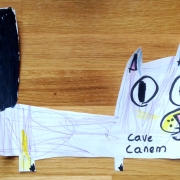Hereford, Hawkins and Hoople
“And Prince Eadric and the Welsh became hostile and they attacked the castle-men in Hereford, and did them many injuries. And here the king set a great tax on the wretched people …” (The Anglo-Saxon Chronicle, Worcester Manuscript 1066, pp. 200-201)
It seems that, right up to the Middle Ages, there were quite a few battles waged by the Welsh against the English in Hereford, which probably gave rise to many myths, and perhaps the most famous of these are the supposed laws about your rights to shoot a Welsh person with a longbow on a Sunday in the Cathedral Close in Hereford. A spokesperson for the Law Commission has confirmed: “It is illegal to shoot a Welsh or Scottish person regardless of the day, location or choice of weaponry.”
So, denied this right by law, I left my bow and arrow behind and drove into the city to deliver ceramics to the Timothy Hawkins Gallery – just a stone’s throw from the Cathedral, but it was a weekday anyway, not a Sunday. Church Street, where the gallery is, is a stone-paved lane that leads from the close to the main square, free of traffic, and with cafes, it is much used by pedestrians as a short-cut.
Timothy Hawkins himself is an artist craftsman who makes beautiful bespoke furniture, and the gallery is an outlet for some of his work, but also for others. Glass, textiles, metal work, ceramics, as well as wood, is on display, and after you’ve paid a visit, you can go and visit the Chained Library and the Mappa Mundi at the Cathedral before going to one of the fine pubs for a drink.
The main square itself is used as a market once a week, and I was reminded that many years ago a young Edmund de Waal used to sell his ceramics there when he set up a studio in the eighties. His work is minimalist and functional, but also sensual because, as he says, “of the knowledge our own hands hold when we make things”. Touch is important to him, as it was to another potter, born in Hereford, Simon Carroll.
Quite a contrast with de Waal’s work, Carroll’s is exuberant and risk-taking, and he was a whizz with glazes.
Who else has Hereford connections? Well, three incredibly famous actors: David Garrick, Sarah Siddons and Nell Gwynn, Charles II’s mistress. And singer songwriter Ellie Goulding. And, of course, Mott the Hoople, glam rock band whose greatest hit was All the Young Dudes, written for them by David Bowie to stop them splitting up, which they were on the verge of doing – you of a certain age will enjoy listening to it again: click here.
And if any of you enjoy your sport, you may remember one if the greatest footballing upsets in FA Cup history when Hereford United beat Newcastle 2–1 in January 1972, when they were still a non-league side and Newcastle were in the top division of English football. Have a look at Ronnie Radford’s goal here.
Historically, Hereford was once part of Wales (thus all those battles) and there is still a debate that crops up now and again as to whether the county would be better off as part of Wales and not England, to the extent that some believe that Herefordshire has become mecca for people from the South East and London to build their castles in their very own corner of ‘England’, to the detriment of Hereford’s “Welshness”, defined as infectious high spirits, combined with recklessness, generosity, and a ready wit (all of which Nell Gwynn had in spades).
Two English tourists are driving through Wales and visit the place with the longest name in Europe –Llanfairpwllgwyngyllgogerychwyrndrobwllllantysiliogogogoch (“St Mary’s Church in the Hollow of the White Hazel near a Rapid Whirlpool and the Church of St. Tysilio near the Red Cave”). They stop for lunch and one of the tourists asks the waitress: “Before we order, I wonder if you could settle an argument for us. Can you pronounce where we are, very, very, very slowly?”The girl leaned over and said: “Burrr… gurrr… King.”




















